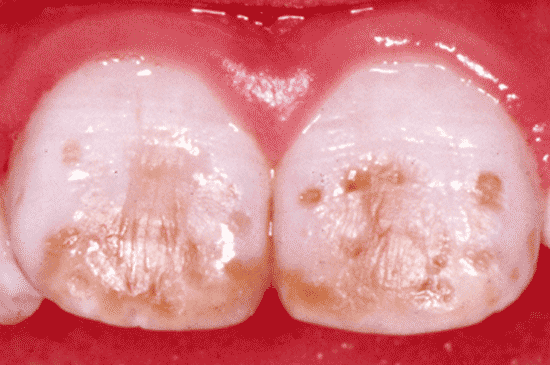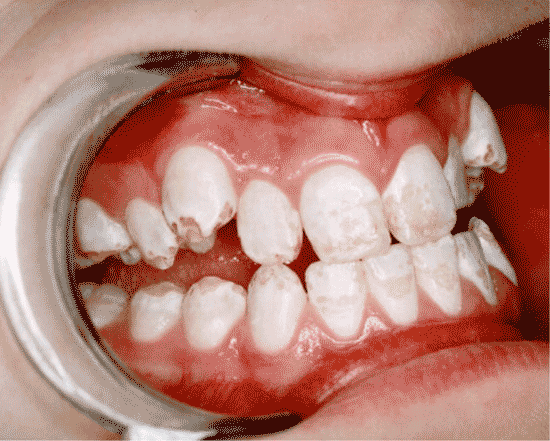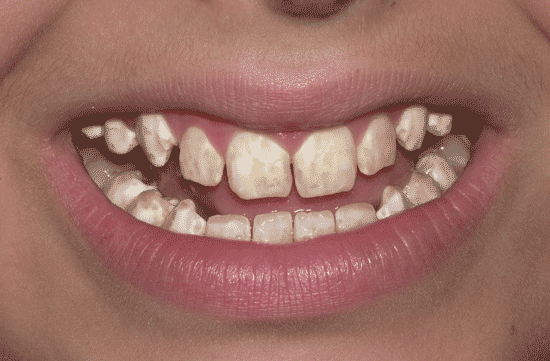Teeth with “moderate” and severe dental fluorosis are marked with widespread and often highly disfiguring staining of the enamel. These stains, which can have a dark brown and black color, can cause acute embarrassment to a child and significant teasing from peers. This can have significant repurcussions on a child’s social and emotional development in the form of reduced self-esteem and confidence. A Surgeon General’s panel of doctors and scientists concluded that both severe and moderate fluorosis are adverse health effects due to the pscyhological impacts these conditions will foreseeably have on the impacted child. As noted by one member of the Surgeon General’s panel:
“I think that the sense of the committee is that the cosmetic effect represents an adverse health effect, that this is psychologically damaging. People walk around covering their mouths.”

Severe fluorosis
Impact on Tooth Quality
In addition to widespread staining, moderate and severe fluorosis are more prone to attrition and wear than teeth without fluorosis. In the severe forms of fluorosis, this can result in widespread chipping, fracture, and decay — effects which further intensify the disfiguring appearance of the condition. Since the erosion of enamel in severe fluorosis can impair the function of the tooth, the National Research Council concluded in 2006 that severe fluorosis is an adverse health effect.
Although moderate and severe fluorosis were once rarely seen in the U.S., the latest national figures from the CDC show that approximately 3 to 4% of American teenagers now have the condition, with black children suffering the highest rates. The elevated rate of disfiguring dental fluorosis in the black community has prompted calls from civil rights leaders to end water fluoridation programs.
CLASSIFICATION CRITERIA (DEAN’S FLUOROSIS INDEX):
Moderate: “All enamel surfaces of the teeth are affected, and the surfaces subject to attrition show wear. Brown stain is frequently a disfiguring feature.”
Severe: “All enamel surfaces are affected and hypoplasia is so marked that the general form of the tooth may be affected. The major diagnostic sign of this classification is discrete or confluent pitting. Brown stains are widespread and teeth often present a corroded-like appearance.”
To see Dean’s complete index, with descriptions of very-mild to mild fluorosis, click here.
IMPACT ON TOOTH QUALITY:
“Severe enamel fluorosis is characterized by dark yellow to brown staining and discrete and confluent pitting, which constitutes enamel loss… One of the functions of tooth enamel is to protect the dentin and, ultimately, the pulp from decay and infection. Severe enamel fluorosis compromises that health-protective function by causing structural damage to the tooth. The damage to teeth caused by severe enamel fluorosis is a toxic effect that is consistent with prevailing risk assessment definitions of adverse health effects.”
SOURCE: National Research Council. (2006). Fluoride in Drinking Water: A Scientific Review of EPA’s Standards. National Academies Press, Washington D.C.
“In more severely fluorosed teeth, the enamel is pitted and discolored and is prone to fracture and wear. Several studies have found significant increases in the number of decayed, missing, or filled tooth surfaces in children with severe dental fluorosis.”
SOURCE: Agency for Toxic Substances and Disease Registry. (2003). Toxicological Profile for Fluorides, Hydrogen Fluoride, and Fluorine. Department of Health & Human Services, Atlanta, Georgia.
“With more severe forms of fluorosis, caries risk increases because of pitting and loss of the outer enamel.”
SOURCE: Levy SM. (2003). An update on fluorides and fluorosis. Journal of the Canadian Dental Association 69: 286-91.
“fluoride affects the forming enamel by causing porosity, e.g., widening gaps between the enamel rods and enlarging intercrystalline spaces in parts of the rod. With increasing severity, the subsurface enamel all along the tooth becomes increasingly porous… [T]he more severe forms are subject to extensive mechanical breakdown of the surface.”
SOURCE: Aoba T, Fejerskov O. (2002). Dental fluorosis: chemistry and biology. Critical Reviews of Oral Biology and Medicine 13: 155-70.
“Dental fluorosis is characterized by an increasing porosity (hypomineralization) of the subsurface enamel, causing the enamel to appear opaque… In advanced stages, the enamel may become so porous that the outer layers break down and the exposed porous subsurface becomes discolored.”
SOURCE: Fomon SJ, et al. (2000). Fluoride intake and prevalence of dental fluorosis: trends in fluoride intake with special attention to infants. Journal of Public Health Dentistry 60: 131-9.
“the most severe forms of fluorosis manifest as heavily stained, pitted, and friable enamel that can result in loss of dental function.”
SOURCE: Burt BA ; Eklund SA. (1999). Dentistry, Dental Practice, and the Community (5th Ed). WB Saunders Co; Philadelphia.
“In the more severe forms of dental fluorosis, the tooth erupts into the oral cavity entirely chalky white. The degree of porosity (hypomineralization) of such teeth results in a diminished physical strength of the enamel, and parts of the superficial enamel may break away… Such loss of outermost enamel is particularly frequent along incisal edges and cusp tips. In the latter case, this will also involve the occlusal surfaces which become rapidly worn. In the most severe forms of dental fluorosis, the extent and degree of porosity within the enamel are so severe that most of the outermost enamel will be chipped off immediately following eruption.”
SOURCE: Fejerskov O, et al. (1990). The nature and mechanisms of dental fluorosis in man. Journal of Dental Research 69(Spec Iss): 692-700.
“It is difficult to conclude a priori that teeth which spontaneously pit are stronger teeth. Further, data suggest that the effects of fluorosis are not merely discoloration and pitting, but fracturing, caries and tooth loss as well.”
SOURCE: Kimm VJ. (1984). The adverse health effects of fluorosis. Letter from Victor J. Kimm, Director, US EPA Office of Drinking Water, to William D. Ruckelshaus, EPA Administrator. July 26.
“Microhardness of fluorosed enamel is markedly decreased.”
SOURCE: DenBesten PK, Crenshaw MA. (1984). The effects of chronic high fluoride levels on forming enamel in the rat. Archives of Oral Biology 29:675-9.
“more severe degrees of enamel fluorosis are associated with an abnormally high incidence of caries… There is thus no doubt that a high degree of enamel fluorosis causes an increased tendency to caries.”
SOURCE: Carlsson A. (1978). Current problems relating to the pharmacology and toxicology of fluorides. Journal of the Swedish Medical Association 14: 1388-1392.
“Severe mottling is as destructive to teeth as is dental caries.”
SOURCE: Gruebbel AO. (1952). Summarization of the subject. Journal of the American Dental Association 44: 151-155.
“there is ample evidence that mottled teeth, though they be somewhat more resistant to the onset of decay, are structurally weak, and that unfortunately when decay does set in, the result is often disastrous… Caries once started evidently spreads rapidly. Steps taken to repair the cavities in many cases were unsuccessful, the tooth breaking away when attempts were made to anchor the fillings, so that extraction was the only course.”
SOURCE: Smith MC, Smith HV. (1940). Observations on the Durability of Mottled Teeth. American Journal of Public Health 30: 1050-1052.
severe Dental fluorosis as a cause of tooth decay
“[T]he plausible hypothesis concerning elevated frequency of caries in persons with severe enamel fluorosis has been accepted by some authorities, and the available evidence is mixed but generally supportive.”
SOURCE: National Research Council. (2006). Fluoride in Drinking Water: A Scientific Review of EPA’s Standards. National Academies Press, Washington D.C.
“There is no agreement on whether dental fluorosis increases, decreases, or has no effect on caries risk. The reviewed study suggests an increased risk of caries among children with fluorosis. The results are reinforced by the observed dose-response relationship: the higher the fluorosis, the higher the caries prevalence. However this was not a linear relationship; the threshold at which fluorosis appears to start increasing the risk of caries was at TF score 3.”
SOURCE: Cunha-Cruz J, Nadanovsky P. (2005). Dental fluorosis increases caries risk. Journal of Evidence Based Dental Practice 5: 170-171.
“Independent of the fluoride concentration in drinking water, caries prevalence increased consistently with increasing severity of dental fluorosis in the second molars, first molars, premolars and canines.”
SOURCE: Wondwossen F, et al. (2004). The relationship between dental caries and dental fluorosis in areas with moderate- and high-fluoride drinking water in Ethiopia. Community Dentistry and Oral Epidemiology 32: 337-44.
“With more severe forms of fluorosis, caries risk increases because of pitting and loss of the outer enamel.”
SOURCE: Levy SM. (2003). An update on fluorides and fluorosis. Journal of the Canadian Dental Association 69: 286-91.
“[E]levated fluoride levels during enamel maturation can also result in dental fluorosis, which is characterized by hypomineralization of subsurface layers of enamel. In the mildest forms of dental fluorosis, the tooth is fully functional but has cosmetic alterations, almost invisible opaque white spots. In more severely fluorosed teeth, the enamel is pitted and discolored and is prone to fracture and wear. Several studies have found significant increases in the number of decayed, missing, or filled tooth surfaces in children with severe dental fluorosis.”
SOURCE: Agency for Toxic Substances and Disease Registry. (2003). Toxicological Profile for Fluorides, Hydrogen Fluoride, and Fluorine. Department of Health & Human Services, Atlanta, Georgia.
“Both the caries prevalence and the mean caries experience were significantly higher in children with diffuse opacities (dental fluorosis) than in those without…”
SOURCE: Ekanayake L, Van Der Hoek W. (2002). Dental caries and developmental defects of enamel in relation to fluoride levels in drinking water in an arid area of sri lanka. Caries Research36: 398-404.
“The prevalence of caries increased as the degree of fluorosis increased. The mean DMFT was 0.43 in children showing no fluorosis but increased up to 1.65 in children showing a fluorosis score of 3.”
Nanayakkara D, et al. (1999). Dental fluorosis and caries incidence in rural children residing in a high fluoride area in the dry zone of Sri Lanka. Ceylon Journal of Medical Science 42:13-17.
“analyses based on children in the 2.5 ppm area alone, showed significantly higher DMFT (Decayed, Missing, and Filled Teeth) by increased severity of dental fluorosis”
SOURCE: Ibrahim YE, et al. (1997). Caries and dental fluorosis in a 0.25 and a 2.5 ppm fluoride area in the Sudan. International Journal of Paediatric Dentistry 7:161-6.
“The children in the high-fluoride area who had dental fluorosis at or above a TF score of 3 had higher levels of dental caries than those with milder degrees of fluorosis present. This finding suggests that if fluoride intake is too high, severe enamel hypomineralization may result in increased caries risk.”
SOURCE: Cortes DF, et al. (1996). Drinking water fluoride levels, dental fluorosis, and caries experience in Brazil.Journal of Public Health Dentistry 56: 226-8
“The decay rate in the permanent dentition gradually increased with increasing fluorosis severity, a finding not observed in the primary dentition.”
SOURCE: Mann J, et al. (1990). Fluorosis and dental caries in 6-8-year-old children in a 5 ppm fluoride area. Community Dentistry and Oral Epidemiology18: 77-9.
“When the non-fluorosis group was compared to the fluorosis group, there was a significant difference in caries experience; the fluorosis group having higher DMFT and dft… [I]t appears that with increased severity of fluorosis there is increased susceptibility for dental caries.”
SOURCE: Chibole O. (1988). Dental caries among children in high fluoride regions of Kenya. Journal of the Royal Society of Health 108: 32-33.
“A statistically significant positive association was found between caries prevalence and fluorosis; the more caries experienced, the more severe the fluorosis level.”
SOURCE: Mann J, et al. (1987). Fluorosis and caries prevalence in a community drinking above-optimal fluoridated water. Community Dentistry and Oral Epidemiology 15: 293-5.
“The WHO/FAO/UNICEF study (Bohdal, Gibbs and Simmons 1968) in which some 19,000 individuals were examined, a strong positive relationship between the presence of fluorosis and the occurence of dental caries were reported, though the degree of severity of fluorosis was found not to be associated with the incidence of caries.”
SOURCE: Manji F, Kapila S. (1986). Fluorides and fluorosis in Kenya. Part III: Fluorides, fluorosis and dental caries. Odonto-stomatologie tropicale9:135-9.
“It is difficult to conclude a priori that teeth which spontaneously pit are stronger teeth. Further, data suggest that the effects of fluorosis are not merely discoloration and pitting, but fracturing, caries and tooth loss as well. The data which support this statement are presented in attachments 2, 3 and 4. These include peer reviewed case controlled studies which document increase in caries associated with higher degrees of fluorosis, as well as increased rates of caries in some populations exposed to higher levels of fluoride (for levels above the optimal). As the second attachment indicates, five of eight studies found higher caries among those with the more extreme levels of mottling. But, as there are three studies which suggest the obverse, there will be those who wish to continue to argue the point.”
SOURCE: Kimm VJ. (1984). The adverse health effects of fluorosis. Letter from Victor J. Kimm, Director, US EPA Office of Drinking Water, to William D. Ruckelshaus, EPA Administrator. July 26.
” more severe degrees of enamel fluorosis are associated with an abnormally high incidence of caries… There is thus no doubt that a high degree of enamel fluorosis causes an increased tendency to caries.”
SOURCE: Carlsson A. (1978). Current problems relating to the pharmacology and toxicology of fluorides. Lakartidningen 75: 1388-1392.
“there is ample evidence that mottled teeth, though they be somewhat more resistant to the onset of decay, are structurally weak, and that unfortunately when decay does set in, the result is often disastrous… Caries once started evidently spreads rapidly. Steps taken to repair the cavities in many cases were unsuccessful, the tooth breaking away when attempts were made to anchor the fillings, so that extraction was the only course.”
SOURCE: Smith MC, Smith HV. (1940). Observations on the Durability of Mottled Teeth. American Journal of Public Health 30: 1050-1052.


